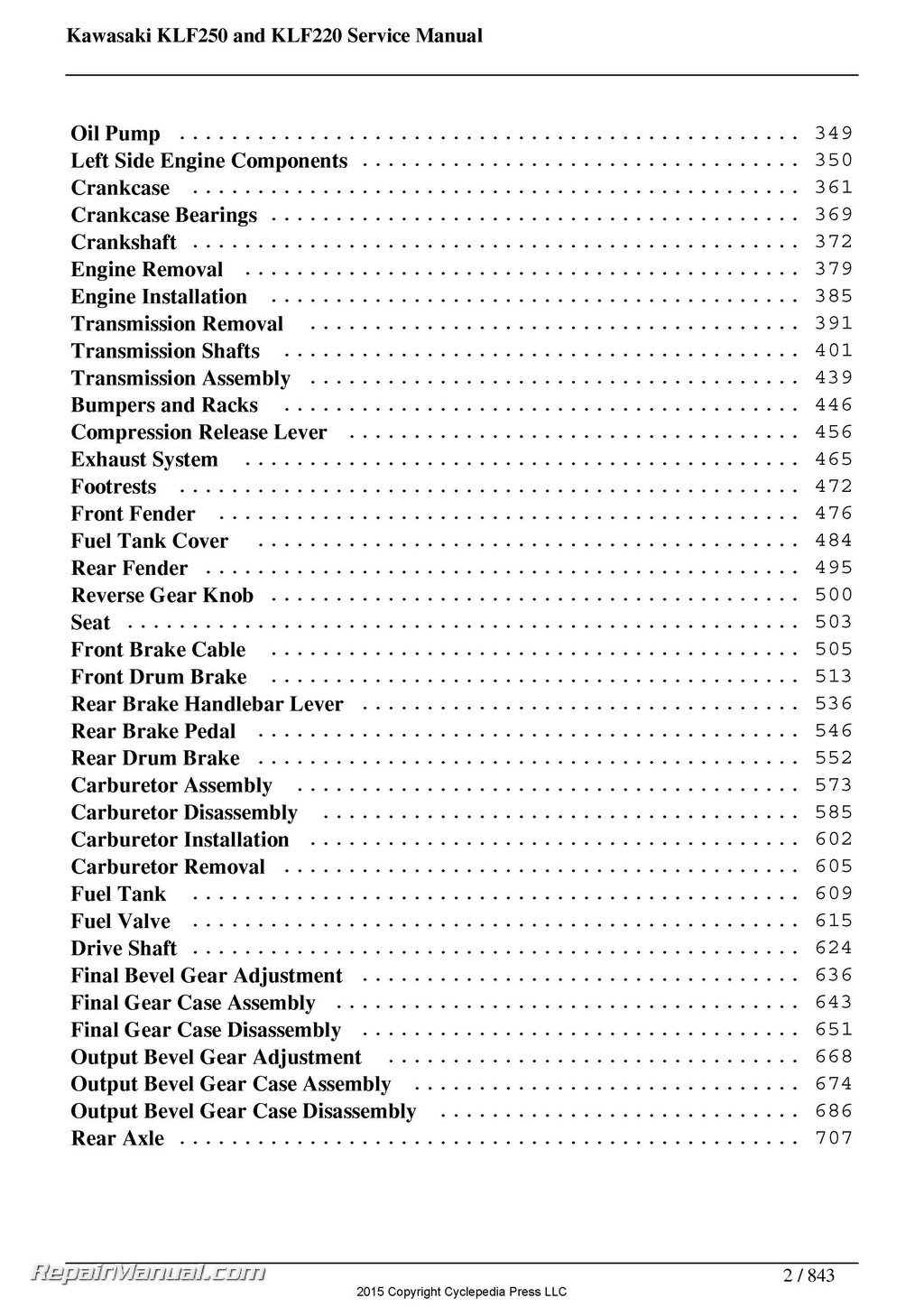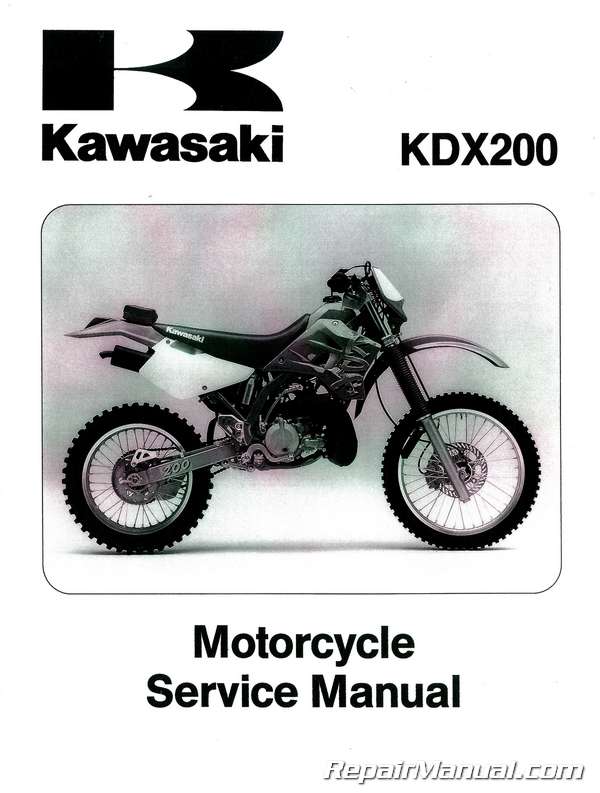
2015 Kdx 220 Service Manual
DescriptionThis Official 1995-2006 Kawasaki KDX200 KDX220 printed Factory Service Manual provides detailed service information, step-by-step repair instruction and maintenance specifications for 1995-2006 Kawasaki KDX200H offroad motorcycles. This repair manual will show you how to clean your KIPS exhaust valve, rebuild your top end, service your clutch and transmission, repair bearings and seals and many other routine tasks. Having the correct information will help you save time, money and get the job done right.1995 1996 1997 1998 1999 2000 2001 2002 2003 2004 2005 2006Note: Since there are some differences between the KDX200 and KDX220 model – KDX220 owners will need to order a supplement manual along with this book. Please see supplement -57. Table of ContentsGeneral InformationFuel SystemCooling SystemEngine Top EndClutchEngine Removal/lnstallationCrankshaft/TransmissionWheels/TiresFinal DriveBrakesSuspensionSteeringFrameElectrical SystemAppendixSupplement – 1998 2001 ModelsSupplement – 2002 2006 Models.
Model History
1980 KDX175A1:
INSTANT DOWNLOAD factory service repair manuals for Kawasaki Concours 14 1400GTR, Concours 14 ABS, D-Tracker, EN500C2, ER-6f, ER-6n, ER-6n ABS, GPX250R, GPZ500S. The Cyclepedia Press LLC Kawasaki KDX200/Kawasaki KDX220 printed motorcycle service manual features 405 pages of detailed black and white.
Introduction year
1981 KDX175A2:
Window port was cut into the intake side of the piston
Exhaust pipe was redesigned with a larger center cone
Carburetor jetting changed
Smaller air filter (for more air intake surface)
Air caps added to the forks
Fork tubes shortened 26mm
Rear suspension Trak links changed to tubular steel
1982 KDX175A3:
New 34mm oval-bore Mikuni carburetor
“Tri-Port Intake” system on cylinder
Additional gusseting on frame
Larger exhaust silencer
New gas cap on tank
All of the A2 and A3 improvements could be retrofitted to the KDX175A1.
Cyclepedia Staff Review
The original KDX175 burst on the scene in 1980 and created a new enduro bike category that previously did not exist among the Japanese motorcycle manufacturers. Looking back, the original KDX175s had their faults, but their positive traits won over all the magazine editors of the time. It seemed as if the KDX175 could do no wrong.
What was not to like? With a peppy engine, fairly light weight, and a phenomenal chassis, the KDX was an enduro rider’s dream. This was the second major enduro bike to be released with a single shock rear end. The main competition was the Yamaha IT175; also a single shock, but with a high mounted rear shock absorber that contributed to a higher center of gravity.
The KDX suspension units, front and rear, were nothing special. The forks were 36mm tube conventional dampers, and the rear shock used a steel body (KX shocks were aluminum), was non-rebuildable and non-adjustable except for spring preload. All of the KDX’s positive handling traits could be attributed to the Uni-Trak rear suspension linkage and the overall design of the chassis. With a wheelbase nearly two inches longer than the competition, the KDX, on paper, looked like it would handle terribly. Exactly the opposite was the case. Kawasaki’s new green machine was effortless to pilot off-road, and an excellent handler under all conditions.
To quote Dirt Bike magazine of March 1982: “It takes a lot of effort to get out of shape on this bike. And if you manage to get into tank-slappers with it, you know you’ve done something horribly wrong.”
There were no substantial changes to the KDX chassis and suspension during its three year run, and magazine critics started grumbling about the steel-bodied shock and small forks near the end.
The KDX engine was also easy to like. It debuted as a peppy 175cc engine in a do it all chassis. Easy starting, clean running and sporting a six speed transmission, there were few complaints in its first year.
Even so, Kawasaki came around with the A2 model in 1981 and substantially upgraded the engine. New porting specs, carburetion and pipe work resulted in a claimed gain of three full horsepower, which was substantial for a 175cc machine. Then, in its third year, Kawasaki changed the cylinder for a new triple-port intake and an oval-bore Mikuni carb that released even more power from the engine. So, if there’s a bar bet involved, the 1982 KDX175A3 was definitely the fastest stock KDX 175 made.
In addition, the A3 received a new set of transmission gears that changed the gear ratios for second, third and fourth gears, ironing out awkward spots in the transmission that elicited some slight amount of complaining with the earlier bikes.
Though the KDX won a lot of fans in its first three years, not all was rosy. The real time bomb inside the KDX, especially the A1, was the Uni-Trak linkage. All the exposed rear pivots were heim joints, which could only hold lubrication so long before severe wear started. The heim joints were easy to see and lubricate, though. What was rarely checked was the central pivot of the Uni-Trak arm, which ran, originally, on a fiber bushing that would wear out quickly and fail suddenly, opening the possibility that the rear end could pound itself into junk without scrupulous maintenance. Later versions of the Uni-Trak link had better bushings, but it was always the “weak link.”
Also, the early KDX machines suffered from a fair amount of vibration, which would increase as the vibrating loosened up the engine mount bolts. Tech stories abounded at the time focused on schemes for replacing the engine mount bolts with larger or stronger bolts. Doing so did nothing to reduce the vibration level of the engine, which was the main problem.
Download for Free. Free 14 day trial. Mac Subscription Service. MindNode on Setapp. MindNode is also available on Setapp, a subscription service for Mac applications. For $9.99 /month you can use all apps included in Setapp without an additional charge. Volume Purchase Program. MindNode - Volume License. Mindnode 6.
Also, the air cooled KDXs used an o-ring as a sealing gasket on the exhaust manifold; a special high-temperature o-ring that was only available through Kawasaki. If neglected, the o-ring could fail, break and get blown out of the exhaust manifold, at which point the KDX would give up about a third of its horsepower. Smart KDX riders kept an eye on their o-rings, and some also sealed the exhaust manifold/pipe union with high-temperature silicone gasket cement with good success.
The bottom line, though, was that complaints were few, and KDX riders rode the wheels off their machines. At the time it was hard to imagine how Kawasaki could improve on a such a fine little bike, but they did. The improvement was called the KDX200A1, and it would be introduced in 1983.
Racing Highlights
Kawasaki’s major racing push for the KDX 175 came in the form of Team True Sport, a national enduro and ISDT racing team headed by Jack Penton (above). Penton organized the team along the lines of the original Penton motorcycle racing team of the 1970s, and during its two-year existence, Team True Sport enjoyed modest success.
Popular Mods
The early ’80s were the height of the “accessory wars” in the dirt bike business, and various bolt on devices promised more horsepower. Items like “boost bottles” and ignition system add-ons were very popular, as well as larger carb kits. Some of these devices actually made the bikes faster.
Much time was spent improving the suspension on the KDX. Terrykit made a fork improver that really worked, though they are no longer available. Stiffer fork springs and accessory shocks were popular. In the September 1981 issue of Dirt Bike, the staff reveals how they grafted a pair of 38mm Marzocchi forks on the front of a KDX, using KX125 triple clamps. Dirt Bike also used a KX 125 Uni-Trak link on the rear of the KDX, to add height to the rear end to make up for the longer forks. Many riders went all the way and used a KX125 rear shock as well, which would save a little weight and add adjustability to the KDX rear end.
Kawasaki KDX175 Service Literature
Specifications

External Links
KDX Enthusiasts pages:
Fredette Racing Products: